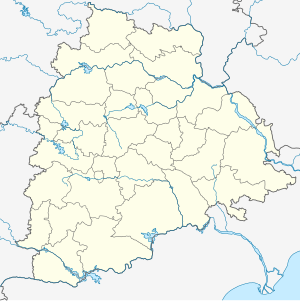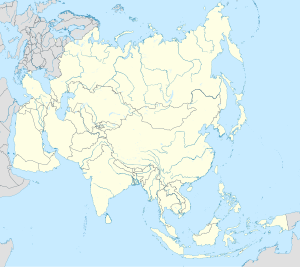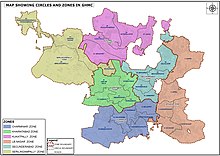A | B | C | D | E | F | G | H | CH | I | J | K | L | M | N | O | P | Q | R | S | T | U | V | W | X | Y | Z | 0 | 1 | 2 | 3 | 4 | 5 | 6 | 7 | 8 | 9
Hyderabad (/ˈhaɪdərəbæd/ (![]() listen) HY-dər-ə-bad;[6] Telugu: , Urdu: ) is the capital and largest city of the Indian state of Telangana and the de jure capital of Andhra Pradesh.[A] It occupies 650 km2 (250 sq mi) on the Deccan Plateau along the banks of the Musi River, in the northern part of Southern India. With an average altitude of 542 m (1,778 ft), much of Hyderabad is situated on hilly terrain around artificial lakes, including the Hussain Sagar lake, predating the city's founding, in the north of the city centre. According to the 2011 Census of India, Hyderabad is the fourth-most populous city in India with a population of 6.9 million residents within the city limits, and has a population of 9.7 million residents in the metropolitan region, making it the sixth-most populous metropolitan area in India. With an output of US$74 billion, Hyderabad has the fifth-largest urban economy in India.
listen) HY-dər-ə-bad;[6] Telugu: , Urdu: ) is the capital and largest city of the Indian state of Telangana and the de jure capital of Andhra Pradesh.[A] It occupies 650 km2 (250 sq mi) on the Deccan Plateau along the banks of the Musi River, in the northern part of Southern India. With an average altitude of 542 m (1,778 ft), much of Hyderabad is situated on hilly terrain around artificial lakes, including the Hussain Sagar lake, predating the city's founding, in the north of the city centre. According to the 2011 Census of India, Hyderabad is the fourth-most populous city in India with a population of 6.9 million residents within the city limits, and has a population of 9.7 million residents in the metropolitan region, making it the sixth-most populous metropolitan area in India. With an output of US$74 billion, Hyderabad has the fifth-largest urban economy in India.
Muhammad Quli Qutb Shah established Hyderabad in 1591 to extend the capital beyond the fortified Golconda. In 1687, the city was annexed by the Mughals. In 1724, Asaf Jah I, the Mughal viceroy, declared his sovereignty and founded the Asaf Jahi dynasty, also known as the Nizams. Hyderabad served as the imperial capital of the Asaf Jahi's from 1769 to 1948. As capital of the princely state of Hyderabad, the city housed the British Residency and cantonment until Indian independence in 1947. Hyderabad was annexed by the Indian Union in 1948 and continued as a capital of Hyderabad State from 1948 to 1956. After the introduction of the States Reorganisation Act of 1956, Hyderabad was made the capital of the newly formed Andhra Pradesh. In 2014, Andhra Pradesh was split to form the state of Telangana, and Hyderabad became the joint capital of the two states with a transitional arrangement scheduled to end in 2024. Since 1956, the city has housed the Rashtrapati Nilayam, the winter office of the president of India.
Relics of the Qutb Shahi and Nizam eras remain visible today; the Charminar has come to symbolise the city. By the end of the early modern era, the Mughal Empire had declined in the Deccan, and the Nizam's patronage attracted men of letters from various parts of the world. A distinctive culture arose from the amalgamation of local and migrated artisans, with Painting, handicraft, jewellery, literature, dialect and clothing are prominent still today. Through its cuisine, the city is listed as a creative city of gastronomy by UNESCO. The Telugu film industry based in the city was the country's second-largest producer of motion pictures as of 2012[update].
Until the 19th century Hyderabad was known for the pearl industry and was nicknamed the "City of Pearls", and was the only trading centre for Golconda diamonds in the world. Many of the city's historical and traditional bazaars remain open. Hyderabad's central location between the Deccan Plateau and the Western Ghats, and industrialisation throughout the 20th century attracted major Indian research, manufacturing, educational and financial institutions. Since the 1990s, the city has emerged as an Indian hub of pharmaceuticals and biotechnology.[7] The formation of the special economic zones of Hardware Park and HITEC City, dedicated to information technology, has encouraged leading multinationals to set up operations in Hyderabad.
History
Toponymy
The name Hyderabad means "Haydar's city" or "lion city", from haydar 'lion' and ābād 'city', after Caliph Ali Ibn Abi Talib, also known as Haydar because of his lion-like valour in battle.[8]
The city was originally called Baghnagar "city of gardens", and later acquired the name Hyderabad.[9][10] The European travellers von Poser and Thévenot found both names in use in the 17th century.[11][12]
One popular legend suggests that the founder of the city, Muhammad Quli Qutb Shah, named it Bhagya-nagar after Bhagmati, a local nautch (dancing) girl whom he married. She converted to Islam and adopted the title Hyder Mahal. The city would have been named Hyderabad in her honour.[13]
Early and medieval history
The discovery of Megalithic burial sites and cairn circles in the suburbs of Hyderabad, in 1851 by Philip Meadows Taylor, a polymath in the service of the Nizam, had provided evidence that the region in which the city stands has been inhabited from the Stone Age.[14][15] Archaeologists excavating near the city have unearthed Iron Age sites that may date from 500 BCE.[16] The region comprising modern Hyderabad and its surroundings was ruled by the Chalukya dynasty from 624 CE to 1075 CE.[17] Following the dissolution of the Chalukya empire into four parts in the 11th century, Golconda—now part of Hyderabad—came under the control of the Kakatiya dynasty from 1158, whose seat of power was at Warangal—148 km (92 mi) northeast of modern Hyderabad.[18] The Kakatiya ruler Ganapatideva 1199–1262 built a hilltop outpost—later known as Golconda Fort—to defend their western region.[15]

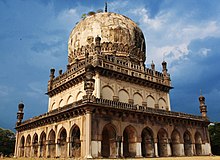
The Kakatiya dynasty was reduced to a vassal of the Khalji dynasty in 1310 after its defeat by Sultan Alauddin Khalji of the Delhi Sultanate. This lasted until 1323, when the Kakatiya dynasty was annexed by Tughlaq dynasty, the successor to the Khaljis.[19] During this period, Alauddin Khalji took the Koh-i-Noor diamond, which is said to have been mined from the Kollur Mines of Golconda, to Delhi.[20] Muhammad bin Tughluq succeeded to the Delhi sultanate in 1325, bringing Warangal under the rule of the Tughlaq dynasty, Malik Maqbul Tilangani was appointed its governor. In 1336 the regional chieftains Musunuri Nayakas—who revolted against the Delhi sultanate in 1333—took Warangal under their direct control and declared it as their capital.[21] In 1347 when Ala-ud-Din Bahman Shah, a governor under bin Tughluq, rebelled against Delhi and established the Bahmani Sultanate in the Deccan Plateau, with Gulbarga—200 km (124 mi) west of Hyderabad—as its capital, both the neighboring rulers Musunuri Nayakas of Warangal and Bahmani Sultans of Gulbarga engaged in many wars until 1364–65 when a peace treaty was signed and the Musunuri Nayakas ceded Golconda Fort to the Bahmani Sultan. The Bahmani Sultans ruled the region until 1518 and were the first independent Muslim rulers of the Deccan.[22][23][24]
In 1496 Sultan Quli was appointed as a Bahmani governor of Telangana, he rebuilt, expanded and fortified the old mud-fort of Golconda and named the city "Muhammad nagar". In 1518, he revolted against the Bahmani Sultanate and established the Qutb Shahi dynasty.[18][25][26] The fifth Qutb Shahi sultan, Muhammad Quli Qutb Shah, established Hyderabad on the banks of the Musi River in 1591,[27][28] to avoid water shortages experienced at Golconda.[29] During his rule, he had the Charminar and Mecca Masjid built in the city.[30] Mir Momin Astarabadi, the prime minister in the Qutub Shahi period, developed the plan of the city of Hyderabad, including the location of the Charminar and Char Kaman.[31][32][33]
On 21 September 1687, the Golconda Sultanate came under the rule of the Mughal emperor Aurangzeb after a year-long siege of the Golconda Fort.[34][35] The annexed city "Hyderabad" was renamed Darul Jihad (House of War),[36] whereas the main territories of the Golconda Sultanate were incorporated into the Mughal empire as the province Hyderabad Subah.[37] Mughal rule in Hyderabad was administered by three main governors: Jan Sipar Khan (1688–1700), his son Rustam Dil Khan (1700–13) and Mubariz Khan (1713–24).[38]
Modern history
In 1713, Mughal emperor Farrukhsiyar appointed Mubariz Khan as Governor of Hyderabad. During his tenure, he fortified the city and controlled the internal and neighbouring threats.[39] In 1714 Farrukhsiyar appointed Asaf Jah I as Viceroy of the Deccan—(administrator of six Mughal governorates) with the title Nizam-ul-Mulk (Administrator of the Realm). In 1721, he was appointed as Prime Minister of the Mughal Empire.[40] His differences with the court nobles led him to resign from all the imperial responsibilities in 1723 and leave for Deccan.[41][42] Under the influence of Asaf Jah I's opponents, Mughal Emperor Muhammad Shah issued a decree to Mubariz Khan, to stop Asaf Jah I which resulted in the Battle of Shakar Kheda.[41]: 93–94 In 1724, Asaf Jah I defeated Mubariz Khan to establish autonomy over the Deccan, named the region Hyderabad Deccan, and started what came to be known as the Asaf Jahi dynasty. Subsequent rulers retained the title Nizam ul-Mulk and were referred to as Asaf Jahi Nizams, or Nizams of Hyderabad.[39][43] The death of Asaf Jah I in 1748 resulted in a period of political unrest as his sons and grandson—Nasir Jung (1748–1750), Muzaffar Jang (1750-1751) and Salabat Jung (1751-1762)—contended for the throne backed by opportunistic neighbouring states and colonial foreign forces. The accession of Asaf Jah II, who reigned from 1762 to 1803, ended the instability. In 1768 he signed the Treaty of Masulipatam—by which the East India Company in return for a fixed annual rent, got the right to control and collect the taxes at Coromandel Coast.[44]
In 1769 Hyderabad city became the formal capital of the Asaf Jahi Nizams.[39][43] In response to regular threats from Hyder Ali (Dalwai of Mysore), Baji Rao I (Peshwa of the Maratha Empire), and Basalath Jung (Asaf Jah II's elder brother, who was supported by French General the Marquis de Bussy-Castelnau), the Nizam signed a subsidiary alliance with the East India Company in 1798, allowing the British Indian Army to be stationed at Bolarum (modern Secunderabad) to protect the state's capital, for which the Nizams paid an annual maintenance to the British.[44]
Until 1874 there were no modern industries in Hyderabad. With the introduction of railways in the 1880s, four factories were built to the south and east of Hussain Sagar lake,[45] and during the early 20th century, Hyderabad was transformed into a modern city with the establishment of transport services, underground drainage, running water, electricity, telecommunications, universities, industries, and Begumpet Airport. The Nizams ruled the princely state of Hyderabad during the British Raj.[39][43]
Post-Independence
After India gained independence, the Nizam declared his intention to remain independent rather than become part of the Indian Union or newly formed Dominion of Pakistan.[44] The Hyderabad State Congress, with the support of the Indian National Congress and the Communist Party of India, began agitating against Nizam VII in 1948. On 17 September that year, the Indian Army took control of Hyderabad State after an invasion codenamed Operation Polo. With the defeat of his forces, Nizam VII capitulated to the Indian Union by signing an Instrument of Accession, which made him the Rajpramukh (Princely Governor) of the state until it was abolished on 31 October 1956.[43][46]
Between 1946 and 1951, the Communist Party of India fomented the Telangana uprising against the feudal lords of the Telangana region.[47] The Constitution of India, which became effective on 26 January 1950, made Hyderabad State one of the part B states of India, with Hyderabad city continuing to be the capital.[48] In his 1955 report Thoughts on Linguistic States, B. R. Ambedkar, then chairman of the Drafting Committee of the Indian Constitution, proposed designating the city of Hyderabad as the second capital of India because of its amenities and strategic central location.[49]
On 1 November 1956 the states of India were reorganised by language. Hyderabad state was split into three parts, which were merged with neighbouring states to form Maharashtra, Karnataka and Andhra Pradesh. The nine Telugu- and Urdu-speaking districts of Hyderabad State in the Telangana region were merged with the Telugu-speaking Andhra State to create Andhra Pradesh,[50][51][52] with Hyderabad as its capital. Several protests, known collectively as the Telangana movement, attempted to invalidate the merger and demanded the creation of a new Telangana state. Major actions took place in 1969 and 1972, and a third began in 2010.[53] The city suffered several explosions: one at Dilsukhnagar in 2002 claimed two lives;[54] terrorist bombs in May and August 2007 caused communal tension and riots;[55] and two bombs exploded in February 2013.[56] On 30 July 2013 the government of India declared that part of Andhra Pradesh would be split off to form a new Telangana state and that Hyderabad city would be the capital city and part of Telangana, while the city would also remain the capital of Andhra Pradesh for no more than ten years. On 3 October 2013 the Union Cabinet approved the proposal,[57] and in February 2014 both houses of Parliament passed the Telangana Bill. With the final assent of the President of India, Telangana state was formed on 2 June 2014.[58]
Geography
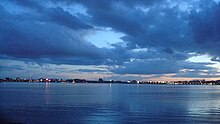
Hyderabad is 1,566 km (973 mi) south of Delhi, 699 km (434 mi) southeast of Mumbai, and 570 km (350 mi) north of Bangalore by road.[60] It is situated in the southern part of Telangana in southeastern India,[61] along the banks of the Musi River, a tributary of Krishna River located on the Deccan Plateau in the northern part of South India.[62][63][64] Greater Hyderabad covers 650 km2 (250 sq mi), making it one of the largest metropolitan areas in India.[65] With an average altitude of 542 m (1,778 ft), Hyderabad lies on predominantly sloping terrain of grey and pink granite, dotted with small hills, the highest being Banjara Hills at 672 m (2,205 ft).[64][66] The city has numerous lakes sometime referred to as sagar, meaning "sea". Examples include artificial lakes created by dams on the Musi, such as Hussain Sagar (built in 1562 near the city centre), Osman Sagar and Himayat Sagar.[64][67] As of 1996[update], the city had 140 lakes and 834 water tanks (ponds).[68]
Climate
Hyderabad has a tropical wet and dry climate (Köppen Aw) bordering on a hot semi-arid climate (Köppen BSh).[69] The annual mean temperature is 26.6 °C (79.9 °F); monthly mean temperatures are 21–33 °C (70–91 °F).[70] Summers (March–June) are hot and dry, with average highs in the mid-to-high 30s Celsius;[71] maximum temperatures often exceed 40 °C (104 °F) between April and June.[70] The coolest temperatures occur in December and January, when the lowest temperature occasionally dips to 10 °C (50 °F).[70] May is the hottest month, when daily temperatures range from 26–39 °C (79–102 °F); December, the coldest, has temperatures varying from 14.5–28 °C (58.1–82.4 °F).[71]
Heavy rain from the south-west summer monsoon falls between June and October, supplying Hyderabad with most of its mean annual rainfall.[71] Since records began in November 1891, the heaviest rainfall recorded in a 24-hour period was 241.5 mm (10 in) on 24 August 2000. The highest temperature ever recorded was 45.5 °C (114 °F) on 2 June 1966, and the lowest was 6.1 °C (43 °F) on 8 January 1946.[72] The city receives 2,731 hours of sunshine per year; maximum daily sunlight exposure occurs in February.[73]
| Month | Jan | Feb | Mar | Apr | May | Jun | Jul | Aug | Sep | Oct | Nov | Dec | Year |
|---|---|---|---|---|---|---|---|---|---|---|---|---|---|
| Record high °C (°F) | 35.9 (96.6) |
39.1 (102.4) |
42.2 (108.0) |
43.3 (109.9) |
44.5 (112.1) |
45.5 (113.9) |
37.4 (99.3) |
36.2 (97.2) |
36.1 (97.0) |
36.7 (98.1) |
34.0 (93.2) |
34.2 (93.6) |
45.5 (113.9) |
| Average high °C (°F) | 29.3 (84.7) |
32.4 (90.3) |
35.9 (96.6) |
38.1 (100.6) |
39.4 (102.9) |
34.9 (94.8) |
31.3 (88.3) |
30.1 (86.2) |
31.1 (88.0) |
31.0 (87.8) |
29.6 (85.3) |
28.7 (83.7) |
32.7 (90.9) |
| Daily mean °C (°F) | 22.7 (72.9) |
25.3 (77.5) |
28.6 (83.5) |
31.3 (88.3) |
33.0 (91.4) |
29.7 (85.5) |
27.0 (80.6) |
26.2 (79.2) |
26.7 (80.1) |
25.8 (78.4) |
23.7 (74.7) |
21.9 (71.4) |
26.8 (80.2) |
| Average low °C (°F) | 15.9 (60.6) |
18.3 (64.9) |
21.5 (70.7) |
24.4 (75.9) |
26.3 (79.3) |
24.2 (75.6) |
22.8 (73.0) |
22.2 (72.0) |
22.3 (72.1) |
20.6 (69.1) |
17.4 (63.3) |
15.1 (59.2) |
20.9 (69.6) |
| Record low °C (°F) | 6.1 (43.0) |
8.9 (48.0) |
13.2 (55.8) |
16.0 (60.8) |
16.7 (62.1) |
17.8 (64.0) |
18.6 (65.5) |
18.7 (65.7) |
17.8 (64.0) |
11.7 (53.1) |
7.4 (45.3) |
7.1 (44.8) |
6.1 (43.0) |
| Average rainfall mm (inches) | 9.3 (0.37) |
9.2 (0.36) |
17.8 (0.70) |
21.7 (0.85) |
31.7 (1.25) |
111.2 (4.38) |
179.2 (7.06) |
207.0 (8.15) |
132.9 (5.23) |
103.6 (4.08) |
26.1 (1.03) |
4.9 (0.19) |
854.6 (33.65) |
| Average rainy days | 0.6 | 0.5 | 1.1 | 1.8 | 2.4 | 6.9 | 10.0 | 11.5 | 7.6 | 5.5 | 1.6 | 0.4 | 49.9 |
| Average relative humidity (%) (at 17:30 IST) | 40 | 32 | 28 | 28 | 30 | 51 | 64 | 69 | 65 | 56 | 48 | 43 | 46 |
| Average dew point °C (°F) | 12 (54) |
12 (54) |
13 (55) |
15 (59) |
15 (59) |
19 (66) |
20 (68) |
20 (68) |
20 (68) |
17 (63) |
15 (59) |
13 (55) |
16 (61) |
| Mean monthly sunshine hours | 272.8 | 265.6 | 272.8 | 276.0 | 279.0 | 180.0 | 136.4 | 133.3 | 162.0 | 226.3 | 243.0 | 251.1 | 2,698.3 |
| Mean daily sunshine hours | 8.8 | 9.4 | 8.8 | 9.2 | 9.0 | 6.0 | 4.4 | 4.3 | 5.4 | 7.3 | 8.1 | 8.1 | 7.4 |
| Average ultraviolet index | 9 | 11 | 12 | 12 | 12 | 12 | 12 | 12 | 12 | 11 | 9 | 8 | 11 |
| Source 1: India Meteorological Department (sun 1971–2000)[74][75][76]Time and Date (dewpoints, 2005-2015)[77] | |||||||||||||
| Source 2: Tokyo Climate Center (mean temperatures 1981–2010)[78]Weather Atlas[79] | |||||||||||||
Conservation
Hyderabad's lakes and the sloping terrain of its low-lying hills provide habitat for an assortment of flora and fauna. As of 2016[update], the tree cover is 1.7% of the total city area, a decrease from 2.7% in 1996.[80] The forest region in and around the city encompasses areas of ecological and biological importance, which are preserved in the form of national parks, zoos, mini-zoos and a wildlife sanctuary. Nehru Zoological Park, the city's one large zoo, is the first in India to have a lion and tiger safari park. Hyderabad has three national parks (Mrugavani National Park, Mahavir Harina Vanasthali National Park and Kasu Brahmananda Reddy National Park), and the Manjira Wildlife Sanctuary is about 50 km (31 mi) from the city. Hyderabad's other environmental reserves are: Kotla Vijayabhaskara Reddy Botanical Gardens, Ameenpur Lake, Shamirpet Lake, Hussain Sagar, Fox Sagar Lake, Mir Alam Tank and Patancheru Lake, which is home to regional birds and attracts seasonal migratory birds from different parts of the world.[81] Organisations engaged in environmental and wildlife preservation include the Telangana Forest Department,[82] Indian Council of Forestry Research and Education, the International Crops Research Institute for the Semi-Arid Tropics (ICRISAT), the Animal Welfare Board of India, the Blue Cross of Hyderabad and the University of Hyderabad.[81]
Administration
Common capital status
According to the Andhra Pradesh Reorganisation Act, 2014 part 2 Section 5:[83] "(1) On and from the appointed day, Hyderabad in the existing State of Andhra Pradesh, shall be the common capital of the State of Telangana and the State of Andhra Pradesh for such period not exceeding ten years. (2) After the expiry of the period referred to in sub-section (1), Hyderabad shall be the capital of the State of Telangana and there shall be a new capital for the State of Andhra Pradesh."
The same sections also define that the common capital includes the existing area designated as the Greater Hyderabad Municipal Corporation under the Hyderabad Municipal Corporation Act, 1955. As stipulated in sections 3 and 18(1) of the Reorganisation Act, city MLAs are members of the Telangana state assembly.
Local government
The Greater Hyderabad Municipal Corporation (GHMC) oversees the civic infrastructure of the city, there are six administrative zones of GHMC: South Zone–(Charminar), East Zone–(L. B. Nagar), West Zone–(Serilingampally), North Zone–(Kukatpally), Northeast Zone–(Secunderabad) and Central Zone–(Khairatabad); these zones consist of 30 "circles", which together encompass 150 municipal wards. Each ward is represented by a corporator, elected by popular vote, as of 2020[update] the city has 7,400,000 voters of which 3,850,000 are male and 3,500,000 are female.[84] The corporators elect the Mayor, who is the titular head of GHMC; executive powers rest with the Municipal Commissioner, appointed by the state government. The GHMC carries out the city's infrastructural work such as building and maintenance of roads and drains, town planning including construction regulation, maintenance of municipal markets and parks, solid waste management, the issuing of birth and death certificates, the issuing of trade licenses, collection of property tax, and community welfare services such as mother and child healthcare, and pre-school and non-formal education.[85] The GHMC was formed in April 2007 by merging the Municipal Corporation of Hyderabad (MCH) with 12 municipalities of the Hyderabad, Ranga Reddy and Medak districts covering a total area of 650 km2 (250 sq mi).[65]: 3 The Secunderabad Cantonment Board is a civic administration agency overseeing an area of 40.1 km2 (15.5 sq mi),[86]: 93 where there are several military camps.[87]: 2 [88] The Osmania University campus is administered independently by the university authority.[86]: 93 Appointed in February 2021, Gadwal Vijayalakshmi of Telangana Rashtra Samithi (TRS) is serving as the Mayor of GHMC.[89]
In Hyderabad police jurisdiction is divided into three commissionerates: Hyderabad (established in 1847 AD, an oldest police commissionerate in India ), Cyberabad, and Rachakonda, each headed by a commissioner of police, who are Indian Police Service (IPS) officers. The Hyderabad police is a division of the Telangana Police, under the state Home Ministry.[90][91]
The jurisdictions of the city's administrative agencies are, in ascending order of size: the Hyderabad Police area, Hyderabad district, the GHMC area ("Hyderabad city"), and the area under the Hyderabad Metropolitan Development Authority (HMDA). The HMDA is an apolitical urban planning agency that covers the GHMC and its suburbs, extending to 54 mandals in five districts encircling the city. It coordinates the development activities of GHMC and suburban municipalities and manages the administration of bodies such as the Hyderabad Metropolitan Water Supply and Sewerage Board (HMWSSB).[92]
Hyderabad is the seat of the Government of Telangana, Government of Andhra Pradesh and the President of India's winter retreat Rashtrapati Nilayam, as well as the Telangana High Court and various local government agencies. The Lower City Civil Court and the Metropolitan Criminal Court are under the jurisdiction of the High Court.[93][94][95]: 1 The GHMC area contains 24 State Legislative Assembly constituencies,[96] which form five constituencies of the Lok Sabha (the lower house of the Parliament of India).[97]
Utility services

The HMWSSB (Hyderabad Metropolitan Water Supply & Sewage Board) regulates rainwater harvesting, sewerage services, and water supply. In 2005, the HMWSSB started operating a 116 km-long (72 mi) water supply pipeline from Nagarjuna Sagar Dam to meet increasing demand.[98][99] The Telangana Southern Power Distribution Company Limited (TSPDCL) manages electricity supply.[100] As of 2014[update], there were 15 fire stations in the city, operated by the Telangana State Disaster and Fire Response Department.[101] The government-owned India Post has five head post offices and many sub-post offices in Hyderabad, which are complemented by private courier services.[64]
Pollution control
Hyderabad produces around 4,500 tonnes of solid waste daily, which is transported from collection units in Imlibun, Yousufguda and Lower Tank Bund to the dumpsite in Jawaharnagar.[102] Disposal is managed by the Integrated Solid Waste Management project which was started by the GHMC in 2010.[103] Rapid urbanisation and increased economic activity has led to increased industrial waste, air, noise and water pollution, which is regulated by the Telangana Pollution Control Board (TPCB).[104][105] The contribution of different sources to air pollution in 2006 was: 20–50% from vehicles, 40–70% from a combination of vehicle discharge and road dust, 10–30% from industrial discharges and 3–10% from the burning of household rubbish.[106] Deaths resulting from atmospheric particulate matter are estimated at 1,700–3,000 each year.[107] The city's "VIP areas", the Assembly building, Secretariat, and Telangana chief minister's office, have particularly low air quality index ratings, suffering from high levels of PM2.5's.[108] Ground water around Hyderabad, which has a hardness of up to 1000 ppm, around three times higher than is desirable,[109] is the main source of drinking water but the increasing population and consequent increase in demand has led to a decline in not only ground water but also river and lake levels.[110][111] This shortage is further exacerbated by inadequately treated effluent discharged from industrial treatment plants polluting the water sources of the city.[112]
Healthcare

The Commissionerate of Health and Family Welfare is responsible for planning, implementation and monitoring of all facilities related to health and preventive services.[113][114] As of 2010[update]–11, the city had 50 government hospitals,[115] 300 private and charity hospitals and 194 nursing homes providing around 12,000 hospital beds, fewer than half the required 25,000.[116] For every 10,000 people in the city, there are 17.6 hospital beds,[117] 9 specialist doctors, 14 nurses and 6 physicians.[116] The city has about 4,000 individual clinics.[118] Private clinics are preferred by many residents because of the distance to, poor quality of care at and long waiting times in government facilities,[119]: 60–61 despite the high proportion of the city's residents being covered by government health insurance: 24% according to a National Family Health Survey in 2005.[119]: 41 As of 2012[update], many new private hospitals of various sizes were opened or being built.[118] Hyderabad has outpatient and inpatient facilities that use Unani, homoeopathic and Ayurvedic treatments.[120]
In the 2005 National Family Health Survey, it was reported that the city's total fertility rate is 1.8,[119]: 47 which is below the replacement rate. Only 61% of children had been provided with all basic vaccines (BCG, measles and full courses of polio and DPT), fewer than in all other surveyed cities except Meerut.[119]: 98 The infant mortality rate was 35 per 1,000 live births, and the mortality rate for children under five was 41 per 1,000 live births.[119]: 97 The survey also reported that a third of women and a quarter of men are overweight or obese, 49% of children below 5 years are anaemic, and up to 20% of children are underweight,[119]: 44, 55–56 while more than 2% of women and 3% of men suffer from diabetes.[119]: 57
Demographics
| Year | Pop. | ±% |
|---|---|---|
| 1951 | 1,085,722 | — |
| 1961 | 1,118,553 | +3.0% |
| 1971 | 1,796,000 | +60.6% |
| 1981 | 2,546,000 | +41.8% |
| 1991 | 3,059,262 | +20.2% |
| 2001 | 3,637,483 | +18.9% |
| 2011 | 6,809,970 | +87.2% |
When the GHMC was created in 2007, the area occupied by the municipality increased from 175 km2 (68 sq mi) to 650 km2 (250 sq mi).[65][123] Consequently, the population increased by 87%, from 3,637,483 as of 2001[update] census to 6,809,970 as of 2011[update] census, 24% of which are migrants from elsewhere in India,[87]: 2 making Hyderabad the nation's fourth most populous city.[1][3] As of 2011[update], the population density is 18,480/km2 (47,900/sq mi)[124] and the Hyderabad urban agglomeration had a population of 7,749,334 making it the sixth most populous urban agglomeration in the country.[3] as of 2011[update] census, there are 3,500,802 male and 3,309,168 female citizens—a sex ratio of 945 females per 1000 males, higher than the national average of 926 per 1000.[125][126] Among children aged 0–6 years, 373,794 are boys and 352,022 are girls—a ratio of 942 per 1000. Literacy stands at 83% (male 86%; female 80%), higher than the national average of 74.04%.[125][127] The socio-economic strata consist of 20% upper class, 50% middle class and 30% working class.[128]
Ethnicity
Referred to as "Hyderabadi", the residents of Hyderabad are predominantly Telugu and Urdu speaking people, with minority Bengali, Sindhi, Kannada, Memon, Nawayathi, Malayalam, Marathi, Gujarati, Marwari, Odia, Punjabi, Tamil and Uttar Pradeshi communities.[129] Hyderabadi Muslims are a unique community who owe much of their history, language, cuisine, and culture to Hyderabad, and the various dynasties who previously ruled. Hadhrami Arabs, African Arabs, Armenians, Abyssinians, Iranians, Pathans and Turkish people are also present; these communities, of which the Hadhrami Arabs or Chaush are the largest, declined after Hyderabad State became part of the Indian Union, as they lost the patronage of the Asaf Jahi Nizams.[129]



